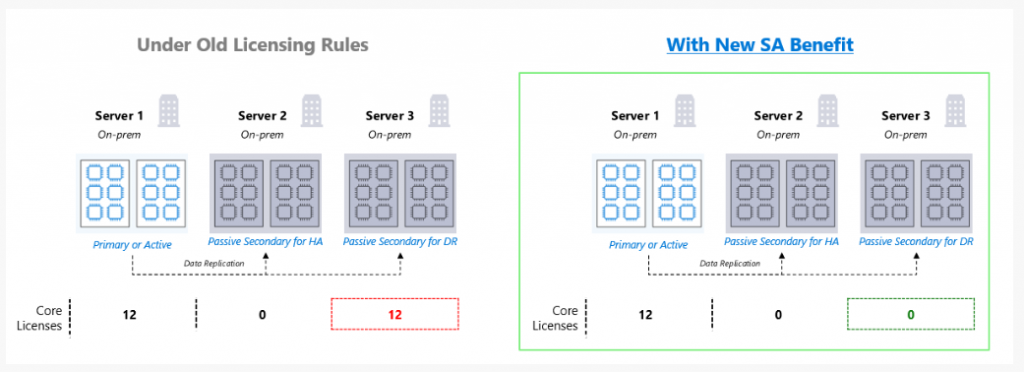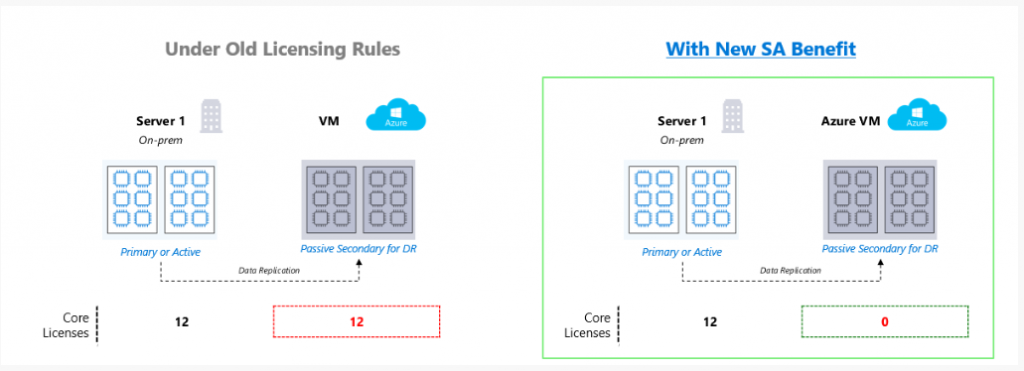Microsoft SQL Server 2019 fail-over changes
November 2019 saw the release of Microsoft SQL Server 2019 and one of the new things it brings is enhanced fail-over and Disaster Recovery rights specific to SQL server.

What are the changes?
With the introduction of the 2019 release, having SQL Server with Software Assurance now means:
- You get a passive server for HA, AND up to 2 additional fail-over servers for DR
- You can use your fail-over SA benefit to cover deployments in Microsoft Azure
These benefits apply to both Standard and Enterprise editions.
Details
The November 2019 Product Terms state that, for SQL Server with SA, you are now entitled to 3 (three) fail-over OSEs (Operating System Environments). You can have:
- 1 x fail-over OSE for “any purpose, including High Availability (HA)”
- 2 x fail-over OSEs “specifically for Disaster Recovery (DR) purposes”. These can be split between:
- 1 x OSE on “any server dedicated to Customer’s use*”
- 1 x OSE on Microsoft Azure
*This must abide by the Outsourcing Software Management clause re: the Listed Providers in the cloud.
These rights do not apply if SQL Server is deployed using the “License Mobility through SA” right. This means if you deploy the primary SQL workload in a 3rd party shared cloud environment, you do not have these fail-over rights available.
Scenarios this enables
Microsoft represent the available benefits like this:

Taken from https://cloudblogs.microsoft.com/sqlserver/2019/10/30/new-high-availability-and-disaster-recovery-benefits-for-sql-server/
As is so often the case with SQL Server, careful understanding and differentiation must be made between the different types of fail-over, and the architecture of solutions, to ensure you don’t find yourself mis-licensed.
Multiple on-premises fail-over servers

Taken from https://cloudblogs.microsoft.com/sqlserver/2019/10/30/new-high-availability-and-disaster-recovery-benefits-for-sql-server/
It is now possible to have 2 fail-over servers covered under SA for a single, primary SQL Server workload; 1 for HA and 1 for DR.
It is to be noted that while the HA fail-over can be synchronous and receive replicated data, the DR fail-over cannot.
Failing over to Azure

Taken from https://cloudblogs.microsoft.com/sqlserver/2019/10/30/new-high-availability-and-disaster-recovery-benefits-for-sql-server/
While it has always been technically possible to fail-over an on-premises server into the Azure cloud – it hasn’t been covered under the Software Assurance benefits; meaning the passive Azure server required licensing, and paying for, as if it were active. Now however, with this added benefit, the Azure virtual machines can be used free of charge:
What is a fail-over OSE?
Microsoft state that DR fail-over instances must be both “asynchronous” and “manual” and that, whether for DR or HA, fail-over instances cannot serve SQL data or run active workloads.
Have Microsoft got the rules right?
This was initially announced via a Microsoft blog which states these changes apply to “any SQL Server release that is still supported by Microsoft” which, at the time of writing, is SQL Server 2012 onwards.
However, the November 2019 Product Terms list these changes under “SQL Server 2019 – Fail-over Rights” and there is no reference to these rights applying retrospectively to other SQL Server releases.
As it stands, a Microsoft blog generally isn’t a strong foundation on which to base licensing decisions so, if you’re running SQL 2012 – 2017, I’d speak to your Microsoft team for further confirmation that the new rights do indeed apply retrospectively. I’ll keep an eye on the Product Terms too and see if anything is added there, either through a revision or in subsequent months.
Further Reading
Microsoft Blog – https://cloudblogs.microsoft.com/sqlserver/2019/10/30/new-high-availability-and-disaster-recovery-benefits-for-sql-server/
Related articles:
About Rich Gibbons
A Northerner renowned for his shirts, Rich is a big Hip-Hop head, and loves travel, football in general (specifically MUFC), baseball, Marvel, and reading as many books as possible. Finding ways to combine all of these with ITAM & software licensing is always fun!
Connect with Rich on Twitter or LinkedIn.

Good info, looking forward to that update about older versions.
There is no sense to think about theese new rules regarding to older versions, because it is an SA benefit. Therefore if you have SA for your licenses, the applicable rules for your licencses will be the latest, because of new version rights.
If you do not have SA, you don’t get the passive failover rights, you have to licencse all of the passive failover servers regardless of you server version…
Because of this, there is no reason for Microsoft to “use reference to these rights applying retrospectively to other SQL Server releases”.If I have SA, it is a 2019 license, regardless of the the installations. If I don’t have SA, I don’t get the SA benefits.